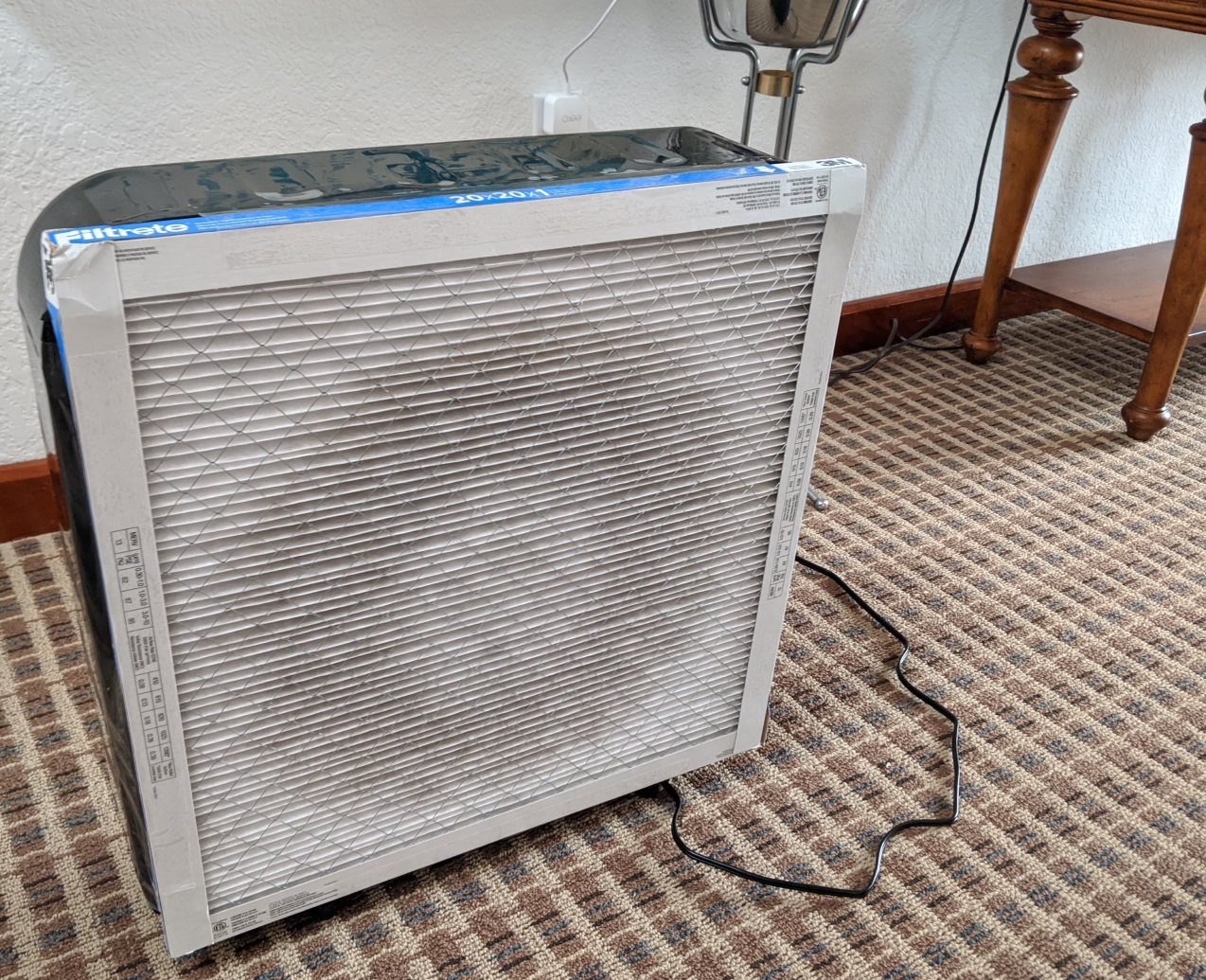If you’re in western USA (like us) at the moment, you might be finding it hard to breath. Breathing air that contains the fallout from fires can make you feel pretty awful, and it can be bad for long-term health as well. Wildfire smoke contains fine particulate matter, known as “PM2.5”, which can be inhaled deep into the lungs. The “2.5” here refers to the size of the particles — they are 2.5 microns or smaller. To see the air quality in your area, check out this AirNow map. Once it’s orange, you might find you start feeling the effects. If it’s red or purple, you almost certainly will. (Sometimes it can appear smokey outside, but the air quality can be OK, because the smoke might be higher in the atmosphere.)
The good news is that there’s a lot you can do to make the air you breathe a lot better. You might be wondering why a data scientist like me is commenting on air filtration… The reason is that I was a leader of the Masks4All movement, including writing the first and most comprehensive scientific paper on the topic, which meant I studied filtration very closely for months. In fact, the size of particles we want to block for wildfires is very similar to the size of particles we want to block for covid-19!
The three ways that you can breathe cleaner air are to use a mask, filter your home central airconditioner or heater, and use fans with filters. I’ll show you the details below. (There’s quite a few links to places you can buy products in this post; I don’t get any commission or anything from them, they’re just things that I’ve personally found helpful.)
Masks
Therefore, you won’t be surprised to learn that one of the most effective things that you can do is to wear a mask. To block most PM2.5 particles you’ll want a mask that’s well-fitted and uses a good filter material. I’ve already prepared advice on that topic for COVID-19, and pretty much all of it is exactly the same for wildfire PM2.5, so go read this now. One bit that’s less of an issue is the “Sanitation” section — wildfire PM2.5 particles aren’t bearing disease, so you only have to worry about sanitation if your mask is actually getting dirty (or if you’ve been out in public with it on).
Personally, I like the O2 nano mask, or any well-fitted mask that you can insert a Filti filter in to. Recent aerosol science tests show that a neck gaiter folded to create two layers works well too (but make sure you add a nose clip to remove gaps around your nose). Check out Etsy for lots of mask designs that include a filter pocket and nose clip.

Filtering your home air
To clean the air in your home, the basic idea is to have it getting continually pushed through a filter. A filter is simply a piece of material which air can get through, but PM2.5 particles can’t. No filter is perfect, but there are readily-available options which work very well. Filters have a MERV rating, which tells you how many small particles they remove. For wildfire, you generally want MERV 13.
Don’t just buy the highest rating filter you can find. Filters with higher ratings have smaller holes (generally speaking), which means they also don’t let air through as fast. Remember, we want your home air going through the filter quickly, to ensure all your air is getting cleaned, so we don’t want the filter to negatively impact air-flow too much. I recommend Filtrete™ Healthy Living Air Filters. These have good air flow even for the MERV 13 spec.
Adding a filter to your central air
If you’ve got central heating or air conditioning, then you’re in luck. That will have strong fans, covering all of your rooms. The trick is to filter the air coming in to the system. Nearly all home systems simply pull their air in through a large vent inside your home. Some units have a filter slot in the unit itself, whereas for some the input vent is in a totally separate location in the house. Note that air conditioners blow air out to outside the house, but they don’t suck air in from outside the house (except, generally, for more fancy commercial building HVAC systems).
Once you’ve found the inlet vent that your central air is pulling in from, add a filter to it. If there’s already one there, make sure it’s MERV 13 or 14. You should change it every 3 months or so (depending on the brand). A vent with a filter installed looks like this:

NB: Most filters have an arrow on the side showing the direction of airflow. So make sure you put it the right way around! Also, make sure you buy the right size. Measure the size of your vent, and buy a filter that is at least big enough to cover the hole. If there are gaps, the air will go through them, instead of your filter!
If there’s not a obvious place to add a filter to your vent, you’ll need to get creative. It might not look pretty, but you could always just remove the vent cover and fasten the filter straight over the top, using tape, poster tack, etc.
Once you’ve got your filter in place, the most important thing is to set your central air settings such that it has the fan running all the time. Most systems have an “auto” setting , which only turns the fan on when heating or cooling. You don’t want that! Set the fan to “on”, not to “auto”. That way, you’re getting as much air through that filter as possible.
Adding filters to fans and portable A/C
I recommend having an air purifier in every room. Most air purifiers don’t really do that much, because they’re normally quiet and small (which means they don’t move much air). There are extra large purifiers for sale, but they’re very expensive, and often sold out at the moment.
But we can create our own air purifier that works as well or better than the big expensive ones. An air purifier is simply a fan blowing air through a filter. So if we use a big fan and a good filter, then we have a good air purifier! The trick is to buy a 20 inch “box fan” (which is just a fan in a 20 inch square box), and stick a 20 inch filter in front of it. We pick 20 inches because that’s pretty big, and a bigger fan and bigger filter means more filtration can happen in a given time.
I bought a few of these box fans: PELONIS 3-Speed Box Fan. I’m not saying this one is any better or worse than any other — just buy whatever you can get your hands on. You want one that has a high speed setting, to push lots of air through.
For filters, anything of the right size and MERV 13 or 14 spec should be fine. I bought this pack of 6 20 inch Filtrete filters. Generally, higher quality filters will allow better air flow. Also thicker filters can increase airflow too; e.g. instead of the 20x20x1 filters I got, you could try 20x20x4 (4 inch thick) filters.
The fans I bought have the on/off/speed switch on the front, so I first turned that to the maximum speed setting, since once I attached the filter I couldn’t access the switch any more. Then I stuck some of this adhesive foam all the way around the front face of the fan, trying to leave no gaps. The idea is that when I then stick the fan on top of this, there will be as few gaps as possible. It would probably work just as well to stick a long piece of poster tack all around the front face. Finally, I stuck the filter to the front of the fan by using a generous quantity of high quality packing tape.

These things are pretty noisy! But it’s a lot better than having a smoky house. They’re also pretty good for helping keep COVID-19 at bay, so if you have a shop or business, sprinkle a few of these around the place if you don’t have good filtered HVAC with a high change rate.
Another approach I’ve found useful is to buy a compact portable air conditioner. These come with a hose that blows hot air out through your window, and sucks air in through the front or back of the unit. You can stick a filter in front of where it sucks air in, using a similar approach to the fan discussed above.
Acknowledgements
Many thanks to Jim Rosenthal of Tex-Air Filters, and to Richard Corsi for the home-made air purifier idea. Jim has a fancier version for those with the budget. Thanks also to Jose-Luis Jimenez, Linsey Marr, Vladimir Zdimal, Adriaan Bax, and Kimberly Prather for many discussions that have helped me improve my (still limited!) understanding of aerosol science.